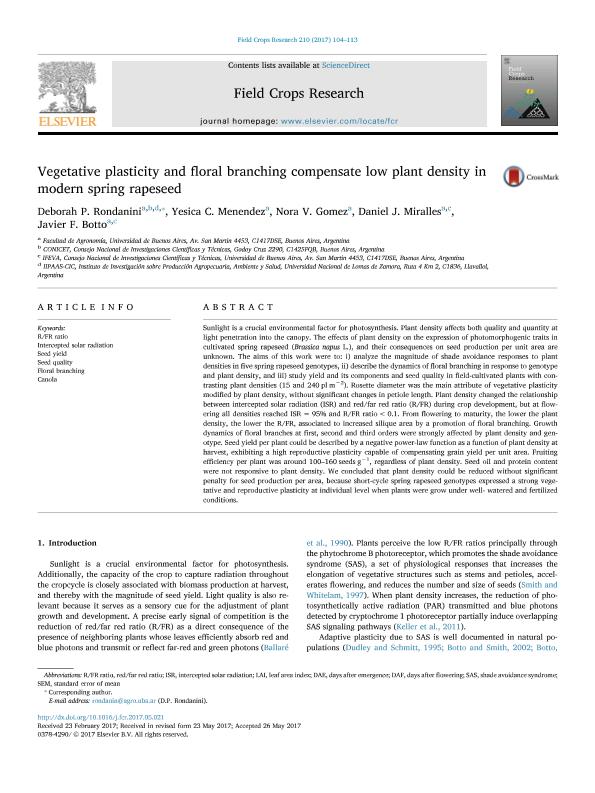Mostrar el registro sencillo del ítem
dc.contributor.author
Rondanini, Deborah Paola

dc.contributor.author
Menendez, Yesica C.
dc.contributor.author
Gomez, Nora V.
dc.contributor.author
Miralles, Daniel Julio

dc.contributor.author
Botto, Javier Francisco

dc.date.available
2018-08-21T14:47:40Z
dc.date.issued
2017-08
dc.identifier.citation
Rondanini, Deborah Paola; Menendez, Yesica C.; Gomez, Nora V.; Miralles, Daniel Julio; Botto, Javier Francisco; Vegetative plasticity and floral branching compensate low plant density in modern spring rapeseed; Elsevier Science; Field Crops Research; 210; 8-2017; 104-113
dc.identifier.issn
0378-4290
dc.identifier.uri
http://hdl.handle.net/11336/56306
dc.description.abstract
Sunlight is a crucial environmental factor for photosynthesis. Plant density affects both quality and quantity at light penetration into the canopy. The effects of plant density on the expression of photomorphogenic traits in cultivated spring rapeseed (Brassica napus L.), and their consequences on seed production per unit area are unknown. The aims of this work were to: i) analyze the magnitude of shade avoidance responses to plant densities in five spring rapeseed genotypes, ii) describe the dynamics of floral branching in response to genotype and plant density, and iii) study yield and its components and seed quality in field-cultivated plants with contrasting plant densities (15 and 240 pl m−2). Rosette diameter was the main attribute of vegetative plasticity modified by plant density, without significant changes in petiole length. Plant density changed the relationship between intercepted solar radiation (ISR) and red/far red ratio (R/FR) during crop development, but at flowering all densities reached ISR = 95% and R/FR ratio <0.1. From flowering to maturity, the lower the plant density, the lower the R/FR, associated to increased silique area by a promotion of floral branching. Growth dynamics of floral branches at first, second and third orders were strongly affected by plant density and genotype. Seed yield per plant could be described by a negative power-law function as a function of plant density at harvest, exhibiting a high reproductive plasticity capable of compensating grain yield per unit area. Fruiting efficiency per plant was around 100–160 seeds g−1, regardless of plant density. Seed oil and protein content were not responsive to plant density. We concluded that plant density could be reduced without significant penalty for seed production per area, because short-cycle spring rapeseed genotypes expressed a strong vegetative and reproductive plasticity at individual level when plants were grow under well- watered and fertilized conditions.
dc.format
application/pdf
dc.language.iso
eng
dc.publisher
Elsevier Science

dc.rights
info:eu-repo/semantics/openAccess
dc.rights.uri
https://creativecommons.org/licenses/by-nc-sa/2.5/ar/
dc.subject
Canola
dc.subject
Floral Branching
dc.subject
Intercepted Solar Radiation
dc.subject
R/Fr Ratio
dc.subject
Seed Quality
dc.subject
Seed Yield
dc.subject.classification
Agricultura

dc.subject.classification
Agricultura, Silvicultura y Pesca

dc.subject.classification
CIENCIAS AGRÍCOLAS

dc.title
Vegetative plasticity and floral branching compensate low plant density in modern spring rapeseed
dc.type
info:eu-repo/semantics/article
dc.type
info:ar-repo/semantics/artículo
dc.type
info:eu-repo/semantics/publishedVersion
dc.date.updated
2018-08-16T15:10:47Z
dc.journal.volume
210
dc.journal.pagination
104-113
dc.journal.pais
Países Bajos

dc.journal.ciudad
Amsterdam
dc.description.fil
Fil: Rondanini, Deborah Paola. Consejo Nacional de Investigaciones Científicas y Técnicas; Argentina. Universidad de Buenos Aires. Facultad de Agronomía; Argentina. Universidad Nacional de Lomas de Zamora; Argentina
dc.description.fil
Fil: Menendez, Yesica C.. Universidad de Buenos Aires. Facultad de Agronomía; Argentina
dc.description.fil
Fil: Gomez, Nora V.. Universidad de Buenos Aires. Facultad de Agronomía; Argentina
dc.description.fil
Fil: Miralles, Daniel Julio. Consejo Nacional de Investigaciones Científicas y Técnicas. Oficina de Coordinación Administrativa Parque Centenario. Instituto de Investigaciones Fisiológicas y Ecológicas Vinculadas a la Agricultura. Universidad de Buenos Aires. Facultad de Agronomía; Argentina. Universidad de Buenos Aires. Facultad de Agronomía; Argentina
dc.description.fil
Fil: Botto, Javier Francisco. Consejo Nacional de Investigaciones Científicas y Técnicas. Oficina de Coordinación Administrativa Parque Centenario. Instituto de Investigaciones Fisiológicas y Ecológicas Vinculadas a la Agricultura. Universidad de Buenos Aires. Facultad de Agronomía; Argentina. Universidad de Buenos Aires. Facultad de Agronomía; Argentina
dc.journal.title
Field Crops Research

dc.relation.alternativeid
info:eu-repo/semantics/altIdentifier/doi/https://dx.doi.org/10.1016/j.fcr.2017.05.021
dc.relation.alternativeid
info:eu-repo/semantics/altIdentifier/url/https://www.sciencedirect.com/science/article/pii/S0378429017303039
Archivos asociados
